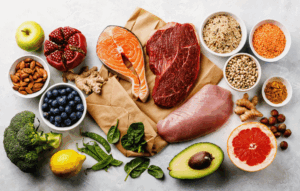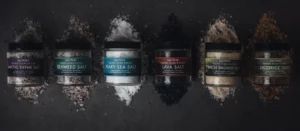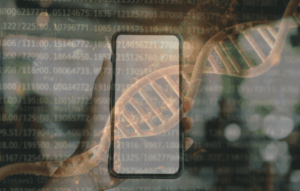You feel like you’ve done everything right.
You cut processed junk, started meal prepping, and hit the gym or trail like a machine. You swapped chips for sweet potatoes, Gatorade for lemon water, and greasy burgers for grass-fed steak. But now… you’re crashing midday, waking up parched, and maybe even cramping during your workouts.
What gives?
Believe it or not, you might be missing just one simple thing: salt.
Yep, salt – public enemy number one for decades. But recent research, and the work of cardiovascular expert Dr. James DiNicolantonio in The Salt Fix, shows we may have had it all wrong. Especially if you’re eating clean, training hard, sweating, or fasting, you might actually need more sodium, not less.
Let’s break it down.
How Salt Got Thrown Under the Bus
Salt has been blamed for high blood pressure and heart disease since the 1970s. That’s when large (and flawed) observational studies began drawing questionable correlations between salt intake and hypertension. The media ran wild. Medical authorities followed suit. And suddenly, salt – an essential mineral humans have craved and consumed for millennia – was demonized.
But here’s the truth: those studies didn’t isolate sodium from ultra-processed food. Salt often came packaged with refined carbs, industrial seed oils, and chemical preservatives – the real culprits behind inflammation and disease.
Dr. DiNicolantonio argues that the anti-salt crusade was one of the biggest mistakes in modern nutrition. His book highlights how salt restriction:
- Raises stress hormones like adrenaline and cortisol
- Increases insulin resistance
- Can actually raise blood pressure in some people due to overactivation of the sympathetic nervous system
In short? We’ve put way too much blame on salt for a crime it didn’t necessarily commit.
Why Sodium Is Essential – Especially for Men Who Move
Sodium isn’t just a seasoning. It’s a fundamental electrolyte. Your body uses it to:
- Maintain proper hydration
- Regulate nerve impulses
- Help muscles contract
- Balance blood volume and pressure
- Support adrenal and hormonal function
Without enough sodium, your body goes haywire. You may feel:
- Brain fog or dizziness
- Fatigue or weakness
- Muscle cramps
- Headaches
Lightheadedness when standing up
Constant thirst despite drinking water
And if you’re an active guy – training hard, sweating often, or spending time in saunas/steamrooms/jacuzzies – you’re flushing sodium fast. One hour of intense exercise can easily drain 500–1,000 mg of sodium, and that loss multiplies in hot or humid conditions.
Add in a clean, whole-food diet (which naturally contains very little sodium), and you’ve got a recipe for low sodium without realizing it.
Why Clean Eaters Are Often Sodium Deficient
So, processed food is packed with sodium, often artificially inflated to preserve shelf life and trigger cravings. This is something most of us are generally aware of, but rarely realize the full implications of.
When you start cleaning up your diet, you’re likely eating foods like:
- Eggs
- Grass-fed beef and other natural proteins
- Leafy greens
- Avocados
- Whole potatoes (not fries)
- Fruits and berries
- Nuts and seeds
More or less.
So these are all amazing, but all naturally pretty low in sodium.
So if you used to get 3,000–4,000 mg of sodium a day from processed food, and now you’re barely hitting 1,000 mg, your body’s suddenly running on empty. This often explains why some people can actually feel worse after switching to a healthier diet – a paradox that’s rarely talked about in the wellness world; this is really common when people are fasting or running a keto/low-carb system.
Signs You Might Not Be Getting Enough Salt
Sodium deficiency isn’t just about the obvious salt cravings. Here are some lesser-known signs that your body might be screaming for more:
- You feel lightheaded when standing up quickly (aka orthostatic hypotension)
- Your muscles fatigue or cramp easily during workouts
- You’re peeing frequently, even if you’re not drinking much
- You feel wired but tired – high cortisol, low stamina
- You wake up thirsty and dry-mouthed
- You drink tons of water, but never feel truly hydrated
If you’re ticking multiple boxes above, sodium could be your missing link.

The Hormonal Connection: Sodium, Stress, and Testosterone
Here’s where it gets really interesting for men.
Low sodium = high aldosterone = high cortisol
That hormonal combo tells your body it’s under stress. Over time, this leads to:
- Poor testosterone production
- Increased inflammation
- Poor sleep
- Reduced recovery and resilience
Restoring sodium helps ease the burden on your adrenal glands, stabilize your nervous system, and create an internal environment primed for strength, stamina, and sex drive.
How Much Sodium Do You Actually Need?
The current U.S. Dietary Guidelines suggest limiting sodium to 2,300 mg/day – about 1 teaspoon of salt.
But for active guys, that may be dangerously low.
Dr. DiNicolantonio and others argue that 3,000–5,000 mg of sodium/day is more appropriate for people who:
- Eat a whole-food, low-processed diet
- Train 3–6 days a week
- Spend time in saunas or sweat a lot
- Use a good bit of caffeine or intermittent fasting (both increase sodium loss)
Pro Tip: 1 gram of sodium = ~2.5 grams of salt. So to get 4,000 mg of sodium, you’d need around 2 teaspoons of unrefined salt per day.
How To Add Salt Back (The Smart Way)
The goal is not to reincorporate high-sodium junk food. It’s to reclaim control of your sodium intake with quality sources.
Here’s how:
Use High-Quality Salt
Skip iodized table salt. Opt for:
- Clean sea salt, like Saltverk, Jacobsen, or Maldon
- Redmond Real Salt – but maybe pause on this one for a minute, as there’s a bit of a controversy going on around lead that the health world has yet to fully confirm

These contain trace minerals like magnesium, potassium, and calcium for added health benefits.
Salt to Taste
Liberally salt your food – especially starchy carbs like sweet potatoes, rice, and fruit. Sodium helps glucose and nutrients enter your cells more effectively.
Drink Electrolytes Pre- or Post-Workout
Try this DIY mix:
- 16–20 oz filtered water
- 1/4 tsp sea salt
- Juice of half a lemon
- Optional: 1/8 tsp magnesium glycinate or splash of coconut water
Great for replenishing what you sweat out without the junk found in sports drinks.
Add Salt to Morning Hydration
Especially if you’re fasting or doing hot yoga, a pinch of salt in your lemon water first thing can restore overnight losses.
Pro Tip: 1 gram of sodium = ~2.5 grams of salt. So to get 4,000 mg of sodium, you’d need around 2 teaspoons of unrefined salt per day.
So… Should You Go Wild on Sodium?
Not quite.
Again, this isn’t about loading up on pretzels and ramen noodles. It’s about reclaiming intentional sodium intake in a way that supports your goals, hormones, and performance.
If you’re active, clean-eating, and sweating a lot, salt is not your enemy. It’s a vital tool.
Final Take: Don’t Fear The Salt Shaker – Use It Strategically
Salt is finally making a comeback – and for good reason.
It’s not just a seasoning. It’s a performance enhancer, hormone stabilizer, and hydration optimizer. And for clean-eating, active men, it may be the missing link to feeling clear-headed, strong, and fully fueled.
So next time you finish a workout drenched in sweat, or sip plain water and still feel thirsty, consider this:
You’re not broken.
You’re (probably) not overtraining.
You’re probably just low on salt.
Try adding some back and feel the difference.








